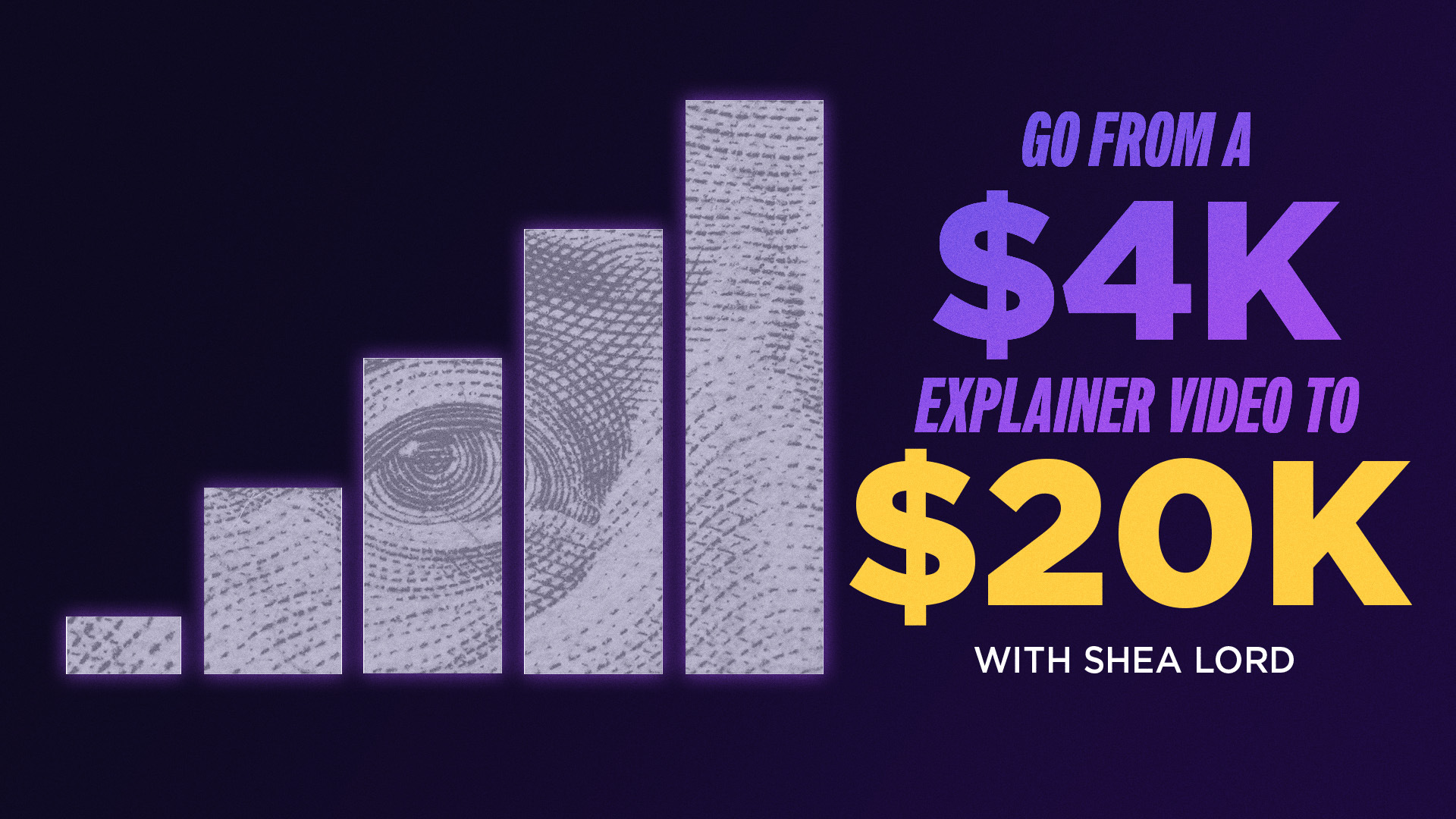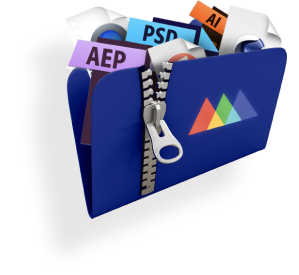
How do you demonstrate your value as an animator and designer to go from $4k projects to $20k?
You’ve been working as a freelance artist for years, but your projects still only bring in $4,000. How do you break into the higher-end market, with bigger clients and more rewarding paychecks? Want to raise your rates and 5x the value of your work? If you don’t know how to price your motion design, you’ll end up on a path to burnout: no freetime, no balance, stressed, and in poor health. Put the keyframes away for a minute and let’s talk about money.

What’s the difference between a $4,000 explainer video and a $20,000 explainer video? Hint: it’s not just the art. We’re going to cover how to increase your rates with studios, create your own flexible pricing system, and how to land 5-figure deals with direct clients by crafting no-brainer offers that make you both excited to work together.
I recently finished a $52k project. The client probably paid another 20% (minimum) of that to the studio that produced it. The work took me about 10 days to complete, revisions and all.
- Total run time: 1:20.
- Style: 2D corporate Memphis.
- One rigged character. I didn’t even have to design it.
And the client? Thrilled.
In the past, I’ve done triple the work for a tenth of the price. So what gives? I’ve learned that pricing is based on the value of the business problem you can solve for your client. If you want to turn $4k into $20k, you have to craft the right offer for the right person.
In this article, we’ll show you how to reach your goals with:
- Time-Based Pricing Models
- Deliverable-Based Pricing Models
- Value-Based Pricing Models
$20k with Time-Based Pricing
Most studios will expect you to provide a day or hourly rate. This is time-based pricing. Your options to increase your income with a studio client will be limited to either increasing the length of the booking, which you don’t have much control over, or increasing your rates.
At $500/day, you’ll need 40 days of solid booking to hit $20k. If you are always booked and never take a day off, that’s an annual income of about $130,000.
There are three ways you can raise your day rate to take home more money in less time.
Hone your skill and/or specialize
The most straightforward approach to raising your rates is to become a better motion designer! If a studio knows they can rely on you to tackle a tough shot and impress the client, you can charge a premium.
Action steps:
- Master the craft with advanced classes at School of Motion
- Learn specialized software or techniques
- Develop a unique style
Level up to director-level positions
Climb the creative ladder into a director-level role. It’s more responsibility, but also more creative control. You’ll be paid for your strategic creative thinking, plus your ability to apply it to the work as you lead a team.
Action steps:
- Position yourself as a director or art director for hire
- Build a portfolio that demonstrates your creative leadership
- Show off your ability to carry a project from seed through completion
- Take every opportunity for more ownership of a project
Become the reliable go-to
Studios tend to prioritize reliability and communication over unpredictable keyframe wizardry. Everyone loves working on a cool project and making cool art, but most of the time clients just need the work done. So peace of mind is worth a little extra cash as insurance.
Take freelancer Austin Saylor for example. In his journey to break $200k, he raised his day rate to $900, expecting studios to decline. Not only did they accept, but after a successful project they kept bringing him back. Austin is an ace motion designer, but traditionally we think of these rates as reserved for industry celebs or hardcore specialists. Not always the case.
Action steps:
- Focus on your soft skills, especially communication
- Keep a positive attitude even when the going gets tough
- Be an active listener and critical thinker— save your clients from having to hold your hand (provide solutions instead)
- Be action-oriented
- Craft a time-management system that keeps you delivering on-time
- Go learn more from Austin
Not sure what your day rate should be? Check out this breakdown by Josh Alan.
If you follow all of these steps and find that you are working with a client/studio that can’t support higher rates or longer bookings, it’s time to start marketing yourself to studios that can. Regardless, exchanging time for money is difficult to scale for profit because when you gain speed, you lose money.
$20k with Deliverable-Based Pricing
The deliverable is the final file(s) that you hand off to the client. If it’s one video, the price should be set to the cost of producing the video, plus your profit margin.
The cost of producing a video comes down to estimating a timeline (day/hour rate) and putting a value on your skill or the level of complexity of the product you’re creating. For example, a 1 minute 3D explainer with a cast of fully-rigged characters and heavy renders is going to be way more expensive to produce than a 2D piece that only uses text and icons to deliver the same information.
Tiered price ranges
The problem with assigning a value to the complexity of your work is that it doesn’t account for how valuable the outcome of the project will be for the client.
You can make it more flexible by assigning levels of complexity to tiers of price ranges. This way the client can decide if they’re in the market for a simple, low-tier deliverable, or something more complex and expensive.
The price ranges will be based on your market (what kind of problems are you solving?) and comparable work. In other words, ask other freelancers what they charge. You can also check out this fun pricing calculator by Get Wright On It to see how someone else breaks down the numbers.
Non-definitive example:
- Tier 3: Text and icons only ($4-6k+ per minute)
- Tier 2: Detailed illustrations, engaging motion, and simple characters ($10-15k+ per minutes)
- Tier 1: Fully-rigged characters, fancy transitions, maybe some 3D ($20k+ per minute)
Let’s say a client’s 1-minute script has 6 scenes. 5 of them could be tier 3 simple. But one scene will require some tier 1 magic. You can calculate the cost scene-by-scene as a fraction of the time to get a total.
Tier 3 animation: 50 seconds @ $5,000
Tier 1 animation: 10 seconds @ $3,500
+ Timeline: 15 days @ $500/day
Take that cost and add anywhere from 20-50% for a standard profit margin. That’s the price.
Any time you give a quote to a studio, they’re going to add their margin to the top of your quote and pass that cost on to the client. Operating at-cost is unsustainable.
If your baseline cost to produce a 60 second video is $8,500, plus your time (15 days at $500/day) and your profit margin is 25%, that’s $20,000.
Action steps:
- Track your time to estimate the cost of producing different kinds of deliverables
- Structure your own tiers according to your services and clientele
- Decide on a profit margin based on your market and positioning (motion design is generally a premium service, but maybe you want to be a luxury brand)
$20k with Value-Based Pricing
As a studio freelancer, you get to focus on a creative art problem. When you’re working directly with businesses, you’re stepping into a bigger role as a creative strategist, too. That means picking up a new set of skills and honing your systems-thinking to help businesses achieve measurable results— which you can base a price on.
The more ownership you can take over a project, the more value you’re providing. It’s a bigger opportunity to set your price, and a bigger risk. If you can deliver results, you’ll make 💰.
With direct clients, you can use value-based pricing to land 5- and 6-figure projects in 3 steps:
- Identify clients with bigger problems to solve
- Position yourself as the solution
- Craft a tailored, no-brainer offer
A great offer has a price-tag that is a fraction of the outcome. To be worth $20,000, the project needs to solve a $100,000 problem. Who’s going to say no to 5X-ing their investment? It’s a no-brainer.
Sounds great, but how does a freelancer pull it off, practically speaking? If you jump into VBP before establishing yourself as an expert, you may scare off potential clients and even harm your reputation. Start slow, and work on growing your business acumen, particularly in your target client’s market, so you can speak the same language and build trust.
Action steps:
- Work with the client to identify a measurable outcome for the project (KPIs)
- Work with the client to understand the value of that outcome
- Price the project at a fraction of that value
- Hone your systems-thinking to provide better creative strategy
- Bonus tip: take a week to learn media buying and start offering campaign management so you have direct control over your client’s KPIs
Mix and match, make it rain 💸
You don’t have to commit to one pricing model. Instead, it can depend on the client and the situation. It will take time to acquire and curate a clientele that works for your financial goals and the kind of career you want to design.
Use time-based pricing when working with most studios and low-commitment direct clients.
Price for deliverables when time-based billing would punish you for being fast, but there isn’t enough information to craft a solid value-based offer. Create value tiers to give your clients more flexibility, if needed.
When you can position yourself as an expert and establish a business relationship with the client, use value-based pricing to craft a measurable, win-win deal.
How I doubled my income
Two years ago I was making around $120,000/year. That felt great. I wanted to teach other motion designers how to break the 6-figure ceiling, so I built a would-be course on the subject.
But I realized I wasn’t following some of my own advice. Instead of publishing, I decided to buck up and put it to the test.
It worked. Last year I invoiced for $247k.
My work is pretty good. It’s well-crafted, nothing fancy. But two years ago I would not have pegged it as a $200k+ portfolio.
It came down to understanding the insane value motion design provides businesses, having my pricing systems in place, and a bit of courage to follow-through with them.
The point? If I can do it, so can you.
If you want to learn more, I go in-depth on pricing, negotiation, getting clients, and running a freelance business in my weekly newsletter, The Freelance Operating System. You can also follow me on LinkedIn for daily tips.
Check out these resources:
- The Small Business Administration
- Hourly Pricing is Nuts by Jonathan Stark
- Austin Saylor’s Project $200k journey
- Animation Pricing Calculator
- How I Doubled my Freelance Income











